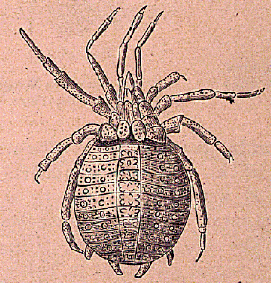Trigonotarbida and their Allies

A number of Carboniferous arachnids somewhat resembled spiders, and in fact appeared at about the same time as the first true spiders. Like spiders, they were terrestrial and respired through book lungs, and walked on eight legs. However, they were not true spiders, nor necessarily ancestral to them, but represented independent offshoots of the Arachnida. Trigonotarbids are currently the oldest known land arthropods. Most of these fossils are found in the Upper Carboniferous (Pennsylvanian), though they have also been found in the Ludlow Lane fauna of England (Pridolian, late Silurian), the Alken an der Mosel fauna of Germany (Emsian, early Devonian) the Rhynie Chert of Scotland (Siegenian, early Devonian) and the Gilboa, New York fauna from the Panther Mountain formation (Givetian, middle Devonian). Not much is known about their relationships; we present them on one page primarily for convenience.
Eophrynus prestvichi, shown above as illustrated in Karl Zittel's 19th-century textbook of paleontology, is from the Upper Carboniferous of England. It belongs to one of the better-known Carboniferous arachnid groups, the Trigonotarbida, which may be most closely related to a group of soft-bodied, small arachnids known as the Palpigrada. Unlike true spiders, Eophrynus has a broad junction between prosoma ("head") and opisthosoma "abdomen"). Another trigonotarbid, Pleophrynus, from the Mazon Creek deposits of Illinois, may be seen at the Illinois State Museum.
Architarbids were another Late Carboniferous group of arachnids. Orthotarbus, also from Mazon Creek, is one example of an architarbid. Note that the abdomen has ten segments; the first five are abbreviated and thickened, while the last five are broad and indistinctly demarcated. The specimen is also from the Illinois State Museum.

Petrunkevitch, A. 1960. Arachnida. P42-P162 in Moore, R.C. (ed.) Treatise on Invertebrate Paleontology. Part P: Arthropoda 2: Chelicerata. Geological Society of America and University of Kansas Press, Lawrence, Kansas.

